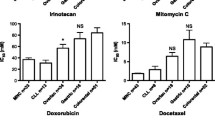Summary
To determine the optimal concentration time factors for the fluoropyrimidines 5-fluorouracil (FU), 5-fluorouridine (FUR), and 5-fluoro-2′-deoxyuridine (FUdR) in regional chemotherapy, we tested these drugs against the colorectal carcinoma cell line HT 29 at various dosages and exposure times. The measure of cytotoxicity used was the degree of inhibition of colony formation in soft agar after drug treatment compared with untreated control cells. Colonies were visible after 6 days of growth in soft agar, so the initial evaluation of toxicity was done at this time. Additional colonies were found 10 and 16 days after the first evaluation, so the dishes containing the treated cells were also evaluated for this delayed growth phenomenon (“regrowth”), which we considered to be due to a cell growth inhibition effect of the drugs rather than a cytocidal effect. Exposure times of the cells to the drugs ranged from 5 min to 24 h and the doses, between 0.01 and 1000 μg/ml. The toxicity of FUdR was concentration-dependent, but its time dependence ceased after a relatively short exposure time. There was a cell population that was not susceptible to FUdR regardless of dose and exposure time; consequently, FUdR treatment was always accompanied by substantial regrowth of colonies. With FU and FUR, conditions could be achieved that resulted in complete cell death (no regrowth), but high concentrations and long exposure times were required with FU. With FUR, on the other hand, both cytostasis and cytoxicity could be achieved with substantially lower doses and shorter exposure times than with FU. These results indicate that FUR has the potential to be an effective drug in chemotherapy protocols not involving systemic administration.
Similar content being viewed by others
References
Aigner KR, Link KH, Stemmler S, Warthona M (1985) Intraarterielle infusion experimentelle und pharmakokinetische. Beitr Onkol 21:84
Calabro-Jones PM, Byfield JE, Ward JF, Sharp TR (1982) Time-dose relationships for 5-fluorouracil toxicity against human epithelial cancer cells in vitro. Cancer Res 42:4413
Carter SK (1976) large bowel cancer. The current status of treatment. J Natl Cancer Inst 56:3
Drewinko B, Yang LY (1985) Cellular basis for inefficacy of 5-FU in human colon carcinoma. Cancer Treat Rep 69:1391
Drewinko B, Yang LY, Ho DHW, Benvenuto J, Loo TL, Freireich EJ (1980) Treatment of cultured human colon carcinoma cells with fluorinated pyrimidines. Cancer 45:1144
Ensminger W, Neiderhuber J, Gyves J, Thrall J, Cozzi E, Doan K (1982) Effective control of liver metastases from colon cancer with an implanted system for hepatic arterial chemotherapy. Proc Am Soc Clin Oncol 1:94
Fraile RJ, Baker LH, Buroker TR, Horwitz J, Vatikevicius VK (1980) Pharmacokinetics of 5-fluorouracil administered orally, by rapid intravenous and by slow infusion. Cancer Res 40:2223
Heidelberger C, Danenberg PV, Moran RG (1983) Fluorinated pyrimidines and their nucleosides. Adv Enzymol Relat Areas Mol Biol 54:57
Huberman MS (1983) Comparison of systemic chemotherapy with hepatic arterial infusion in metastatic colon carcinoma. Semin Oncol 10:238
Lokich JJ (1984) Hepatic artery chemotherapy: The relative importance of direct organ distribution vs the constant infusion schedule. Am J Oncol (CCT) 7:125
Moertel CG (1983) Colorectal cancer: chemotherapy as a surgical adjuvant treatment. Bull Cancer 70:329
Myers CE (1981) The pharmacology of the fluoropyrimidines. Pharmacol Rev 33:1
Oberfield RA, McCaffrey MA, Polio BS, Clouse MG, Hamilton T (1979) Prolonged and continuous percutaneous intra-arterial hepatic infusion chemotherapy in advanced metastatic liver adenocarcinoma from colorectal primary. Cancer 44: 414
Sterchi JM (1985) Hepatic artery infusion for metastatic neoplastic disease. Surgery 160:477
Van de Velde CHJ, de Brauw LM, Tjaden UR, de Bruyn EA (1985) 5-Fluorouracil-konzentrationen in Lebergewebe und im Plasma nach intraarterieller Leberperfusion and isolierter Leberperfusion. Beitr Onkol 21:32
Wilkinson DS, Pitot HC (1973) Inhibition of ribosomal ribonucleic acid maturation in Novikoff hepatoma cells by 5-fluorouridine. J Biol Chem 248:63
Author information
Authors and Affiliations
Additional information
P. V. D is the recipient of Grant CH-1H from the American Cancer Society. This study forms part of the doctoral dissertation of K. Peschau
Rights and permissions
About this article
Cite this article
Link, K.H., Aigner, K.R., Peschau, K. et al. Concentration and time dependence of the toxicity of fluorinated pyrimidines to HT 29 colorectal carcinoma cells. Cancer Chemother. Pharmacol. 22, 58–62 (1988). https://doi.org/10.1007/BF00254182
Received:
Accepted:
Issue Date:
DOI: https://doi.org/10.1007/BF00254182




